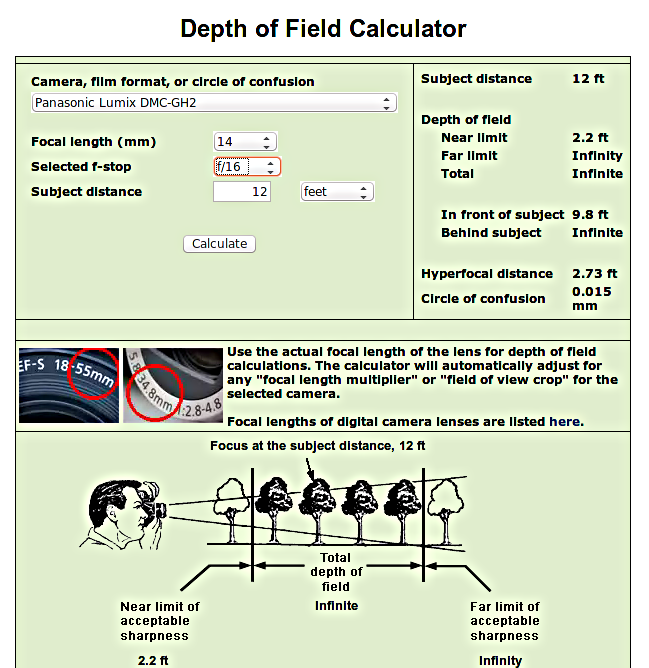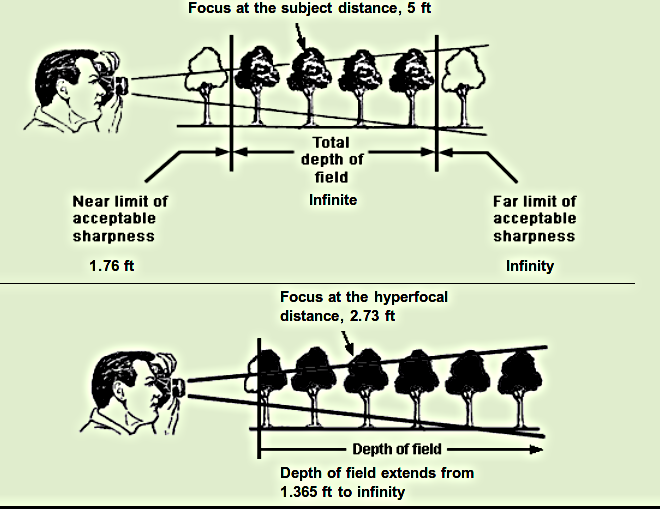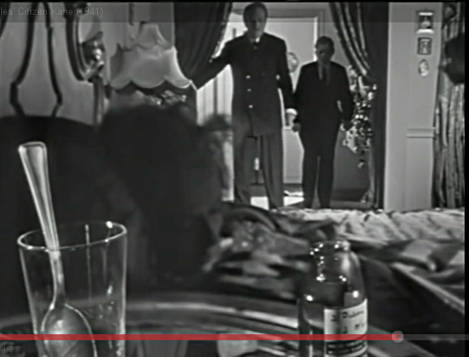
-
Some people call slow lenses give videoish clips. I think deep DOF makes good framing harder as more things are in focus. Nicely framed deep DOF can look quite cinematic. I've seen good looking footages from slow m43 zooms.
-
@goanna Very helpful - thanks.
-
As usual, the DOF calculator site can be useful for lens choice as well as positioning of talent and furniture in such a small space.


-
@goanna I think we'll end up shooting late September. So may be a bit hot here on east coast of US. Hot is good though as sweating during this scene is perfect!
-
Or click on https://www.youtube.com/watch?feature=player_detailpage&v=Ksn_s-Aa_pQ#t=44 to start the video at second in-room scene at 0:44.

-
@matt_gh2 Good luck with the Northern Hemisphere autumn temperatures. Films like Citizen Kane appear dark, but the sets were so brightly lit and hot the actors were apparently getting suntans and sweating!
-
@goanna That's exactly what I was thinking. I've had good luck with those cheap $30 LED 160 lights, so why not get a bunch of them. (That's a cool Orson Welles story.) I think I'll be okay at f8 or f11, but I'll test all f stops ahead of time. Thanks.
-
Lots of light will let you stop down as far as you need (f/22 or so) Luckily, LED lights are cheap, low-wattage and cool to work with.
BTW, even as a novice filmmaker, Orson Welles so insisted on full DOF that he once refused to accept his DOP's insistence that they had to resort to opening up the aperture on a particular shoot: he asked the DOP what frame rate they were shooting at: the reply was 24 fps.Welles then suggested they shoot at 12fps, therefore letting twice as much light enter each frame, allowing them to tighten up the aperture another stop or so and finally allow the everything-in-focus look he insisted upon. This they did, successfully, with Welles, as actor walking and performing all his movements slowly so as to appear normal upon 24fps projection.
-
@CRFilms Tested an 18ft x18ft room using 28mm lens on GH2 and it was enough in terms of field of view for what we're doing. So I'm not too concerned about wide angle lenses, but I'm curious to know what people do to get the whole frame in focus from front to back, in terms of which f-stops to use, if some lenses are better than others, or even if some settings/patches are better for this. Thanks.
-
@matt_gh2 what cam will you use? Gh1/2/3/4 etc...? Even a stock 14mm with the cam mounted flush on the wall or on the floor will show a lot. If that's not enough the 14mm with wide angle adapter will turn it into 11mm for another $100 or so. Worse case, get the 7.5mm and defish in post. Problem is, once you go past F5.6, you need to add LOTS of light.
Also, what about renting or buying a GoPro 3+ Black? Deep DOF and with 2.7k to make defish easier or keep the fisheye as an artistic choice. Or get an external recorder for 1080p 4:2:2, though not 100% if it outputs uncompressed.
-
@goanna Lol - yeah - shooting a scene in a jail, and don't yet know if it's an actual small jail cell or larger holding room. Will know once we do location scout. Hoping to get most of the room in focus, so looking for tips on deep DOF, in terms of lens choice and use, as well as best patch/settings to use.
-
@matt_gh2 12-foot room? Yikes! You might have to use a 12mm lens at f/22 and do as Orson Welles did - either cut a hole in a wall or a hole in the floor:

-
Any recommendations on which lenses and f-stops combined with which settings/patches would yield the best deep DOF? I'm shooting a scene in a room that may be anywhere from 12 ft x 12 ft to 20 ft x 20 ft, and wanted the whole room to be in focus.
-
I'm not crazy about the character design, and what is mainly disturbing is that it looks like a weak plagia from INNOCENCE (Ghost In The Shell 2) which is one of my favorite anime ever : Especially the HUD ideogram interface that is focusing.
-
It's about framing, indeed. Now i remember. :)
I think this guy has the cinematic eye
-
@Stonebat I do a lot of landscape photography and timelapse photography and what you are saying about framing a moving shot with the same deliberateness as a still shot is something that has been second nature, but so very important. But one other aspect that`s integral is how you react to light in your processing/exposure.
If you can do it without getting too much noise in the shadows, you`d be surprised how much richness and drama you can add to a scene framed by clouds by just stopping down the exposure while filming. It`s not just a "technical trick", it`s a shift of emphasis: suddenly you aren`t just documenting foreground and middleground elements, but instead capturing the path of the light, the drama of where it reaches and exaggerating the "distances" between the places it reaches, and those it does not.
I think that if you go out and shoot the same focal length (back when I was first practicing, that 28mm in terms of 35mm equivalent), without moving your tripod, from a place you find visually interesting, for 3 hours, 3 times in one week, you`ll start, just start to get a sense for what REALLY separates the shots that interest you from the ones that don`t.
Shooting video in addition to stills helps you find where the codec, etc. add additional considerations, but the framing is so key on it`s own. :) -
@thepalalias Thanks a lot for the tips. I've been watching other people's works on vimeo, and I like deep DOF scenes that look like wide angle photo framing. It's certainly not a photo as there are moving subjects or slow panning, but it gives stunning result. The photo framing must capture intended message in single frame which is a major difference from the video. But there seems no clear borderline. I've been taking JPEG photos straight out of a camera. Preferably deeper DOF if there is enough lighting. I come home and go through the photos quickly. I think this is one way to improve video framing quickly. Going through photos is much quicker than watching all "testing" video clips. Some photos can give quite cinematic feel. See this guy's photostream. http://www.flickr.com/photos/bryaniceman/ His day job is a cinematographer, and his hobby is street photography. His photos look like frame captures from movies. Most of his photos have deep DOF. When he uses shallow DOF, wow stunning photos from his Nikkor AF 180mm f/2.8D IF-ED http://www.flickr.com/photos/bryaniceman/sets/72157622807061864/ Scouting is important. So true. A photographer took awesome street photos from his GF1. People asked him why his photos look so great. He's been walking the same streets everyday for 10 years.
@johnnym I like shallow DOF from longer focal length lens like everyone else :)
-
Thanks a lot johnnym.
-
superbly shot, @ghostlayer
-
I make big different between Youtube that I consider as "broadcasting Sewers" where any kind of "stuffs" are dumped to a random audience and Vimeo Community that is really stimulating and inspiring. (and that is why I hardly ever surf on Youtube)
I must confess that I work in the film industry as VFX Compositor so I work all day long on feature films and commercials so what I can make the difference when I try to develop my tiny personal projects shot on zero budget on my own... I can experience much more freedom on that field. -
@ghostlayer
It's fairly easy to distinguish cinematic work from videoish work. It depends on how far a maker or a production team has gone to achieve their desired intension. It doesn't really matter whether it's a set of working gears, a bag full of in-camera and post-processing tricks, a good script, a good narration, or good acting. You know... something enticing viewers. Although youtube has a bunch of crappy videos enticing gozillions of viewers, I bet most viewers wouldn't watch same youtube video twice. The final artifact should entice viewers more than a few times. But I just don't know how. Haha. Prolly it must come from learning experience based on the good old trial and error.
I watched your video about 5 times. Nice work. -
Thanks for sharing my work (Such Vivid Memories) and discussing it.
Cinematic/Filmic is a great and difficult quest :)
I think that it's a combination of many settings : DOF, framerate/shutter speed, lens behavior, color grading is very important to my opinion too.
Best
Jean-Baptiste -
Another wasted Sunday :)
-
-
@stonebat
my personal pseudo-cinematic lens rules:
have something in the foreground, something in the background
if you have nothing to contrast before-back, shoot anamorphic or crop to 2.35 (Actually shoot as little as possible at infinity, unless with an anamorphic or cropped to 2.35. :))
of course the rule is DOF = long -> long lenses stopped down,
but DOF = not too long -> short lenses not focused at infinity (unless shooting pseudo-anamorphic or with something blurred contrasting in foreground)
maybe too simple? i could shoot cinematic stuff with my HV20 when zoomed in and stopped down (and slightly underexposed of course) -
@StoneBat Oh, and spend LOTS of time scouting locations so that when an idea seizes you, you have a good sense of where to go. I implied that earlier but never got explicit. :) Keep an eye out for naturally/artificially beautiful or negative and film either congruent or contrary to that to get the effect you want.
Howdy, Stranger!
It looks like you're new here. If you want to get involved, click one of these buttons!
Categories
- Topics List23,980
- Blog5,725
- General and News1,352
- Hacks and Patches1,152
- ↳ Top Settings33
- ↳ Beginners255
- ↳ Archives402
- ↳ Hacks News and Development56
- Cameras2,362
- ↳ Panasonic992
- ↳ Canon118
- ↳ Sony156
- ↳ Nikon96
- ↳ Pentax and Samsung70
- ↳ Olympus and Fujifilm100
- ↳ Compacts and Camcorders300
- ↳ Smartphones for video97
- ↳ Pro Video Cameras191
- ↳ BlackMagic and other raw cameras115
- Skill1,960
- ↳ Business and distribution66
- ↳ Preparation, scripts and legal38
- ↳ Art149
- ↳ Import, Convert, Exporting291
- ↳ Editors191
- ↳ Effects and stunts115
- ↳ Color grading197
- ↳ Sound and Music280
- ↳ Lighting96
- ↳ Software and storage tips266
- Gear5,417
- ↳ Filters, Adapters, Matte boxes344
- ↳ Lenses1,580
- ↳ Follow focus and gears93
- ↳ Sound498
- ↳ Lighting gear314
- ↳ Camera movement230
- ↳ Gimbals and copters302
- ↳ Rigs and related stuff273
- ↳ Power solutions83
- ↳ Monitors and viewfinders340
- ↳ Tripods and fluid heads139
- ↳ Storage286
- ↳ Computers and studio gear560
- ↳ VR and 3D248
- Showcase1,859
- Marketplace2,834
- Offtopic1,319









